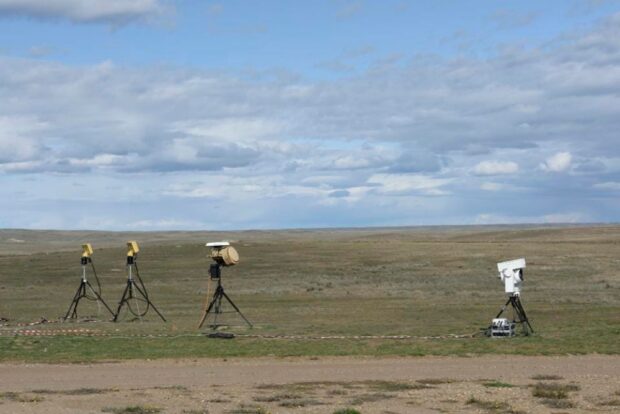Turkey’s vaunted domestically-built drones pose a significant challenge for Greece, a challenge Athens has recently begun addressing with Israeli know-how.
Greece has secretly implemented a “veritable umbrella against enemy unmanned aerial vehicles” over islands and other important sites across the country during the past two months, Vassilis Nedos wrote in the Greek daily Kathimerini.
The system uses Israeli technology to blind drones and disrupt their flight plans.
“It is basically a version of an anti-UAV system that has features similar to those of Israel’s Drone Dome, but adapted to the specific needs of Greece and the geographical terrain of the islands and other border areas,” Nedos wrote.
Built by Israel’s Rafael Advanced Defense Systems, the Drone Dome, as the name suggests, specializes in countering enemy drones. It can neutralize drones by jamming their communications and GPS. For fully autonomous drones, it uses an invisible 10-kilowatt laser that can down drones up to two miles away.
Rafael offers its clients customized versions of the system, as it has most likely done in this case for Greece.
Greek-Israeli defense ties have recently expanded. In 2021, the two countries signed a $1.68 billion defense deal, the largest in their history, which included acquiring M-346 trainer aircraft and establishing a flight school in Greece. It is, therefore, unsurprising that Athens has acquired the Drone Dome and possibly other similar Israeli systems.
(Athens wanted to keep the Drone Dome acquisition under wraps, and Israeli arms manufacturing companies do not publicly disclose who their customers are as a matter of policy.)
As detailed here, Greece’s ongoing acquisition of 24 4.5-generation fighter jets from France, its upgrade of 84 F-16s to the latest Block 72 configuration, and a possible, if not likely, future acquisition of at least 20 fifth-generation F-35 Lightning II stealth jets will give the Hellenic Air Force (HAF) a substantive technological edge over its Turkish rival by the end of this decade.
On the other hand, Turkey already has a much larger and more advanced drone fleet.
In February, retired Greek General Evangelos Yeorgusis wrote an article outlining how Turkish drones making regular flights from the Evros River to the Greek islands of Kastellorizo and Meis are causing a “headache” for Greece. He noted that Turkish Bayraktar TB2 drones can carry out three to four flights per day to closely monitor the movements of Hellenic warships and defenses on Greek islands.
Constantly scrambling F-16s to intercept these drones poses a major challenge for HAF.
“It is already not easy for Greece to deal with this and it will become even more difficult if Turkey increases the number of drones and the number of flights,” Yeorgusis warned.
Around the same time Yeorgusis’s article came out, the leader of the nationalist Greek Solution party, Kyriakos Velopoulos, questioned the usefulness of high-performance fighter jets such as the Rafale against large numbers of Turkish drones.
“What difference would it make if we buy 200 Rafale jets?” he asked. “Turks will surround us with 400 drones.”
Athens is cognizant of the challenge Turkish drones pose. If it’s not already doing so, it may use the Drone Dome’s powerful sensors to make it more difficult and dangerous for Turkish drones to routinely observe its military movements. It may even use the system’s hard-kill capability in the event of a confrontation.
Denying Turkey effective usage of its clear advantage in drone power will help Greece consolidate its emergent advantage in airpower in any future confrontation. Its acquisition of these Israeli systems is a good start.
Photo: Components of the Rafael Advance Defense Systems Ltd. DroneDome System at the IDEaS CUAS Sandbox.
Source: Forbes

